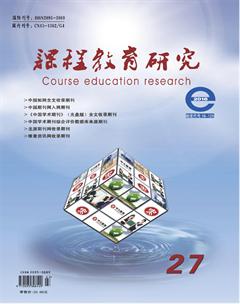从有“笑”到有“效”
梅良武
【中图分类号】G623.2 【文献标识码】A 【文章编号】2095-3089(2018)27-0092-02
一、引言
新英语课程改革强调要改变英语课程过分重视语法和词汇的讲解与传授、忽视对学生实际语言运用能力的培养的倾向,强调课程从学生的学习兴趣、生活经验和认知水平出发,倡导体验、实践、参与、合作与交流的学习方式和任务型的教学途径,发展学生的综合语言运用能力,使语言学习的过程成为学生形成积极的情感态度、主动思维和大胆实践、提高跨文化意识和形成自主学习能力的过程。
笔者在平时的教学实践中,力求践行新课程理念,创造幽默、轻松、和谐的课堂氛围,鼓励学生积极参加课堂活动,大胆实践,培养合作意识和创新精神。以下是笔者在教授译林版《牛津高中英语》模块七第三单元Grammar and usage 版块的实践和感悟。
二、教材分析和学生需要分析
本单元Grammar and usage 版块主要目的是让学生学习和巩固常见的连系动词。概括和总结常见的连系动词及其用法,并通過各种形式进行操练达到熟练和巩固的目的是本节课的重难点和核心所在。这些常见的连系动词大都从初中开始陆陆续续地出现在教材中,只有少数在高中教材里才开始出现。虽然学生的英语水平参差不齐,但大部分学生对常见的连系动词应该很熟悉,这节课应该能很轻松地接受所教内容,能够在教师的指导和鼓励下,积极参与各种活动,不同程度地完成给定任务。
三、教学过程和设计意图
Step 1 Lead in
Teacher enters the classroom, wearing a red scarf as a mask, a wreath made of willow twigs on his head, a small plastic knife in his right hand.(Ss laugh)
T: Good afternoon,everyone.
Ss: Good afternoon ,Mr Mei.
T: Sit down,please.To tell you the truth, I am not Mr Mei. Please stay calm and keep silent. I have good news and bad news for you. Which do you want to hear first?
Ss:Bad news.
T: Bad news.Bad news is that your English teacher has gone with the wind,(Ss laugh) so you wont have any English class today.
S1: Oh, thats great.
T: Dont cut in.
S1: OK., what about the good news?
T: Good news. Good news is that you should give all your(money) to me.
S1: Why is that good?
T: Why is that good? Because then you wont be afraid of being robbed by others.
设计意图:
教师扮演一个强盗出场上课,和学生进行幽默的对话表演,不仅导入了系动词而且让学生兴趣盎然,从而营造出宽松、民主、和谐、幽默的教学氛围。
Step 2 Pair work
Ask students to work in pairs to describe what happened just now. Give them some key words and lead them to use linking verbs to make up sentences intentionally.
(A few minutes later)
T: Tell me what happened.
S2: This afternoon, we, an open class. the bell, rang, remained seated, looked forward to. however, seemed quite strange, English teacher, not turn up, as usual.
T:This is…these are key words. Use them to make sentences,right.ok,sit down, please. Zhu Yuting.
S3: This afternoon we are going to have an open class. After the bell rang, we remained seated and we are looking forward to seeing the teacher.However,everything seemed quite strange and the English teacher didnt turn up as usual.
T: Very good. And now lets check the answer.
This afternoon we would have an open class. When the bell rang, we all remained seated and looked forward to it. However, it seemed quite strange that our English teacher did not turn up as usual.
Now, next. Xing Minghui.
S6: A girl in the front row said “ Bad news first.”The strange man said, “Bad news.The bad news is that English teacher has gone with the wind. You wont have English class today .” The girl said, “Oh, thats good news.”
……
設计意图:
学生在给关键词的提示下试着用含有系动词句子讨论描述刚才发生的事件。为学生提供互相交流的机会,引导学生实践、讨论、合作、探究从而发展说的语言技能。
Step 3 Presentation and guided practice
Display the definition of linking verbs and common usage of linking verbs. Get students to come up with sentences by using linking verbs.
T: Today we are going to learn about something about linking verbs. Now, do you know what a linking verb is? Now look at the screen. What is a linking verb? A linking verb is a word used to connect the subject of a sentence to further information about the state which the subject is in. Now, lets look at the common usage of linking verbs.
The first rule. A linking verb is often followed by an adjective. Let me show you an example. The food tastes good. Here “good”is an adj. The food tastes good. We cannot say “The food tastes well.”because a linking verb is followed by an adj. So could you give me another example.
Han Zhen: I feel so cold now.
T: I feel so cold now. Yeah, you should wear more clothes. Now, the second rule is a linking verb is often followed by a noun. He became a teacher after graduation. Now, Id like you to give me another example. Ten Zhifei.
S9: Mr Mei is our English teacher.
……
这一环节主要帮助学生理解系动词的定义和并对它们的常见用法进行总结和归纳,在此基础上让学生模仿用系动词造句体验和实践系动词的用法。
Step 4 Further practice
T: Now, Id like you to practice more by using linking verbs. Just now, in the short story, who was the robber?
Ss: Mr Mei.
T: Mr Mei was the robber, but do you know the reasons why he robbed his students? Now…. lets look at your handouts,Part B. Why did Mr Mei want to rob his students? Because he was in a good mood. So why he was in a good mood and wanted to rob his students? Use the linking verbs given to rewrite the sentences..
T: OK, now lets check the answers.
S12: The robber prove Mr. Mei
T: The robber proved to be Mr Mei. Next. Wang Guangyu.
S13: He seemed to be in a good mood.
T: He seemed to be in a good mood, yeah. Good, good work. Now, next, Cao Jun.
S14: When he feels happy, he always makes his class interesting.
T: Good job. When he feels happy, he always makes his class interesting.
……
设计意图:
學生根据所发材料上的句子,两人小组合作探究尝试用系动词进行改写句子活动,进一步对系动词常见用法进行操练。
Step 5 Summary and listening :
Help summarize the common linking verbs for students in one Chinese sentence and practice listening to the story using linking verbs.
T: Actually, we know many linking verbs. How can we memorize them well? Now, Id like to teach you a secret. Just read a Chinese sentence. Keep this Chinese sentence in mind. Id like you to read it aloud.
Ss: 证明是;Be ;像;三保;五感;六变
设计意图:
让学生重听老师自编的使用系动词的整个故事,同时通过一句汉语和以板书的形式帮助学生总结和归纳常见的系动词,使之易于理解和记忆。
课堂回放 6:
Step 6 Consolidation (Groupwork )
Have students worked in pairs to make up a short story using linking verbs
设计意图:
让学生分组讨论集体编创小故事,既可以练习听说能力又可以培养合作意识和创新精神。通过小组活动,让学生尝试在日常生活中使用英语,幽默的故事和对话能够让他们体验用英语的快乐,增强成就感和自信心。
Step 7 Homework
Write a short story trying to use as many linking verbs as possible on your exercise book.
设计意图:
通过学生书面作业这一语言输出的实践,可以巩固复习所学常见系动词及其常见用法,培养学生写的能力。
四、总结和反思
通过这节课的教学准备及教学实践,结合笔者课后观看的课堂录像所做的课堂实录和部分老师的听课反馈,可以借鉴之处如下:
1.教学目标明确。整节课的教学设计紧紧围绕常见系动词和用法开展各种活动,教学环节层层递进,符合认知规律。
2.课堂氛围轻松。教师没有师道尊严,幽默有情趣和学生一道表演自编的小故事,学生表现也很机智诙谐,整节课大都在轻松愉快中度过。
3.教学方法新颖。通过创设情境,在情境中了解和操练系动词及其用法,打破了通常语法课枯燥的列规则再练习的模式。
4.活动形式多样。围绕教学目标,活动设计层次分明,形式多样,学生参与面广。
5.板书有味耐看。板书对系动词的总结设计很巧妙,对系动词的常见用法及例句书写工整。
参考文献:
[1]《普通高级中学英语课程标准》(实验稿),北京师范大学出版社,2001.

